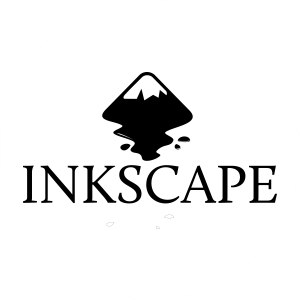
-
Here’s a detailed explanation of Inkscape based on the categories you provided:
1- On which platform are the tools used?
✅ Supported Platforms:
- Windows
- macOS
- Linux (Ubuntu, Fedora, etc.)
- BSD-based OS (FreeBSD, etc.)
💡 Inkscape is a cross-platform vector graphics editor that works on all major operating systems.
2- What hardware requirements are needed?
🔹 Minimum & Recommended System Requirements:
Component
Minimum Requirements
Recommended Requirements
Operating System
Windows 7 or later, macOS 10.11+, Linux
Latest version of OS
CPU
Intel Core 2 Duo or higher
Intel i5/i7, AMD Ryzen 5/7
RAM
2 GB or higher
4 GB or higher
Hard Drive
200 MB of free space
500 MB or more for fonts, extensions
Graphics Card
OpenGL 2.0 support (most modern GPUs)
Dedicated GPU (NVIDIA, AMD) for better performance
Resolution
1024 x 768 or higher
1920 x 1080 or higher
💡 Inkscape runs on most systems but works best on computers with decent processing power and graphics support for larger projects.
3- Installation and membership stages
🔹 Installation:
- Download Inkscape:
- Visit the official Inkscape download page.
- Choose the version for your operating system (Windows, macOS, or Linux).
- Installation Process:
- Windows: Download the .exe file and follow the installation prompts.
- macOS: Download the .dmg file, mount it, and drag Inkscape into the Applications folder.
- Linux: Use package managers like sudo apt install inkscape for Ubuntu-based distributions or download directly from the website.
🔹 Membership/Account Stages:
- Free and Open-Source:
- No registration or membership is required.
- You get access to all features and functionalities without any restrictions.
💡 Inkscape is free and open-source, with no accounts or paid subscriptions required.
4- What can it be used for?
✅ Primary Uses:
- Vector Graphic Design:
- Create logos, illustrations, and scalable vector art for print and digital media.
- Technical Drawings:
- Ideal for precise designs like diagrams, schematics, and blueprints.
- Web Graphics:
- Design UI elements, web layouts, and icons.
- Text & Typography:
- Advanced typography features for creating text-based artwork and designs.
- Illustrations & Cartoons:
- Draw and design digital illustrations, comics, and animations.
- SVG (Scalable Vector Graphics):
- Inkscape uses the SVG format for scalability without quality loss, making it great for web-based applications.
💡 Inkscape is perfect for creating detailed and scalable vector artwork for both print and digital media.
5- What is its prominent feature compared to other tools?
✅ Key Features of Inkscape:
- Free & Open-Source:
- Inkscape is a completely free alternative to tools like Adobe Illustrator.
- SVG-Based Editing:
- Inkscape is fully SVG-compliant, meaning it uses vector graphics that can be scaled infinitely without losing quality.
- Path Editing Tools:
- Inkscape provides advanced path manipulation, making it ideal for detailed vector graphics.
- Node Editing:
- Inkscape allows for easy editing of individual nodes and control points for precise vector artwork.
- Extensive File Format Support:
- It supports a wide range of vector formats (SVG, PDF, EPS, AI, PNG, etc.).
- Advanced Typography Features:
- Inkscape has built-in support for creating professional-quality text-based designs.
💡 The use of SVG and advanced path and node editing sets Inkscape apart from other graphic design software.
6- Sample application made with pictures
Example 1: Logo Design
- Objective: Create a professional logo using geometric shapes and advanced path editing.
- Result: A scalable logo in vector format that can be resized without losing quality.
Example 2: Technical Diagram
- Objective: Design a schematic or blueprint with accurate measurements using Inkscape’s grid system and path tools.
- Result: A clear and precise technical drawing that can be resized without distortion.
7- Which courses can it be used in and is compatible with?
✅ Compatible with Various Courses:
- Graphic Design:
- Logo creation, poster design, and vector artwork.
- Web Design:
- UI/UX design, web elements like icons, and wireframes.
- Digital Illustration & Drawing:
- Illustrating characters, cartoons, and fine art.
- Typography:
- Advanced text manipulation for print and digital materials.
- CAD & Technical Drawing:
- Used for technical diagrams, architectural plans, and engineering designs.
💡 Inkscape is compatible with courses in graphic design, web design, illustration, and technical drawing.
8- Is it free?
✅ Yes, Inkscape is completely free and open-source.
- No paid versions or subscriptions.
- Fully accessible for individuals, students, and professionals.
- You can contribute to its development if you wish.
💡 Inkscape’s open-source nature ensures it is available for everyone at no cost.
9- Links related to it
🔗 Official Website: Inkscape
🔗 Inkscape Download: Download Inkscape
🔗 Tutorials & Documentation: Inkscape Tutorials
🔗 Community & Forum: Inkscape Forum
🔗 Inkscape GitHub (for Developers): Inkscape GitHub🔹 Conclusion
Inkscape is a powerful, free, and open-source vector graphics editor that is ideal for students, graphic designers, illustrators, and web designers. With its robust set of tools for creating scalable artwork and technical diagrams, it serves as a strong alternative to commercial graphic design software like Adobe Illustrator.